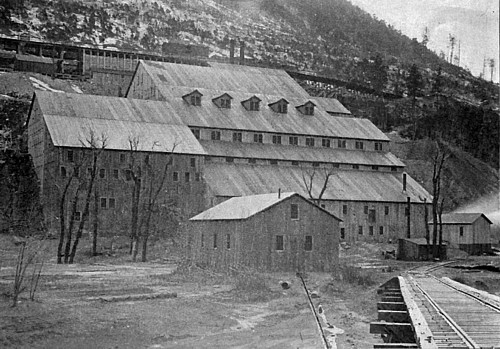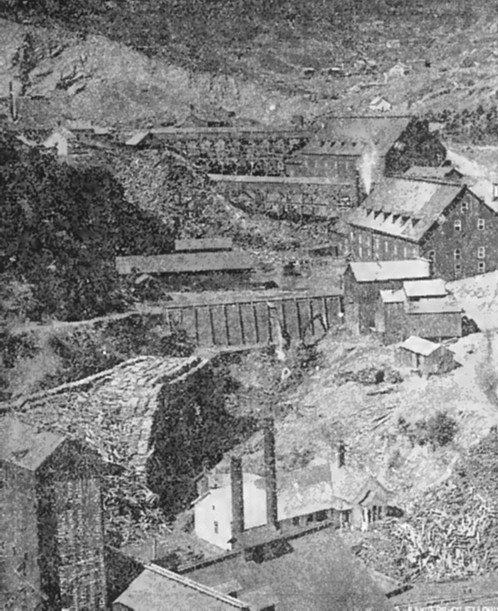Custer City was the first town settled in the Black Hills, and was organized August 10th, 1875. It was at one time nearly depopulated, but is now springing into new life, and the few citizens who had an abiding faith in the final results of their once busy town, are now sanguine of reaping a rich reward. The recent discoveries in the immediate vicinity have caused considerable gold rush excitement, and miners and prospectors are flocking in from all quarters, and that portion of the country bids fair to become a formidable rival to the northern portion of the Hills. The city is most beautifully situated on French Creek in what is known as Custer Park. The scenery is romantic and grand beyond description. Rugged mountain peaks, beautiful parks covered with a luxuriant growth of the finest grass for grazing purposes, with timber in abundance, are salient features. The town now boasts of five hundred inhabitants, a newspaper, and several places of business, and is increasing in population every day. The "Old Bill" Lode, from which gold ore has yielded at the rate of one hundred and thirty-three dollars to the ton; the "Grand Junction" Lode, displaying a fine body of ore, large quantities of which show free gold; the "Atlantic," and other quartz mines, all late discoveries, are now seemingly disputing with the rich gulches in the vicinity of Custer as to which shall be first in importance.
However, the dry gulch diggings near Custer along French Creek should not be overlooked. New discoveries of rich bars have been frequent. Twenty ounces of gold have been taken by three men in one week from these gravels, the pay dirt having to be hauled half a mile to the creek to be washed. Occasionally deposits have been found which produced about one dollar to the pan. Two steam pumps have been in operation near the city, forcing water from French Creek up to these dry diggings for hydraulicing, and with most satisfactory results.
These enterprises are giving new life to the once nearly deserted town, and Custer will soon again put on city airs. The city has good mail and telegraph facilities, and is the nearest point in the Black Hills to be reached from the Union Pacific Railway. Rapid City, which is also one of the oldest towns of the Black Hills, lies in the foot-hills on Rapid Creek, a beautiful mountain stream, which is the largest and finest of its kind in the Hills. The town was commenced in 1875, and some of its founders resisted many Indian attacks and imperiled their lives to protect the new town and its inhabitants. It is the supply point of much of the southern portion of the Black Hills, and is beautifully located at the base of the mountains on both sides of the creek. It contains five or six hundred inhabitants, has good hotels, and strong business firms representing all branches of trade. It has organized good schools, and contains Masonic and Odd Fellows Lodges, and a good weekly newspaper. Rapid Valley is the largest and best watered of any in the Black Hills country. It is fifty miles long, of an average width of two miles, besides valuable uplands in the near vicinity. Irrigation is necessary to crops, and the creek furnishes plenty of water for the purpose. The valley contains a population of three or four hundred outside of the town, and the best farming lands are pretty well taken up for a distance of five miles above and ten miles below the town.
Comfortable dwellings, barns and outhouses, in the midst of fields of grain, are pleasing features to be seen everywhere in the valley. The hills near, are covered thickly with pine, spruce and oak, furnishing plenty of timber for the present, and the country to the east and south toward the South Cheyenne River is a fine grazing region for cattle. Rockford, which is twenty-four miles north-west of Rapid Gity, and twenty-five miles south of Deadwood, on Little Rapid Creek, was organized in 1878. It is the centre of a rich quartz mining district and contains five or six hundred people. It has two large quartz-mills and some mammoth veins of free milling gold quartz ore, though of low grade. When the quartz-mills now going up are completed, there will be about a hundred and fifty stamps within a radius of three miles of the town. It was the scene of a very exciting gold rush stampede during the summer and fall of 1878. Many rich mines have been discovered there, and California capitalists have bought the "Stand-by" Lode for one hundred and twenty-five thousand dollars. The gold ore supply in this section seems to be inexhaustible, and although mostly of low grade, there are frequently streaks in the veins of great richness. This section possesses unlimited water-power in the Little Rapid Creek, which is being utilized to drive quartz-mills, for crushing its ores. When this is accomplished it may become a thriving town. It is in Pennington County.
Rockerville is a growing town in the midst of the richest and most wide-spread placer gold nugget mining district in the Black Hills. It is in Pennington County, fifty-four miles south of Deadwood. The valley and hillsides are rich in dry diggings, coarse gold often being found near the surface. The pay gravel is at present carted in wagons to water and sluiced out. Capital is needed to bring in water. A large population is centering there, and the place is surrounded by good agricultural lands. The population is estimated at seven hundred. Hayward is a village of about two hundred souls, about twelve miles south of Rockerville, in the edge of Custer County. It has a ten stamp mill, some promising quartz mines and some dry placers. In the vicinity of Hayward there are silver mines giving high assays, also copper mines giving assays of sixty percent, copper ore. There is also in the vicinity a mica deposit, sheets of which have been procured five by eight inches of pure isinglass. Near Hayward is the enterprise known as the Battle Creek flume, four miles in length, in which over half a million feet of lumber was used to build it. Much of the material composing this flume was lowered by ropes hundreds of feet from the tops of precipitous mountains. In places iron bars were inserted in holes drilled in the vertical sides of the canon to support the flume, miners having to be suspended by ropes from above while drilling these holes. Hill City is twenty-three miles south-west of Rapid, and is a camp of about two hundred people. Four companies were operating gulch claims, with excellent success. Quartz has been discovered near here, but lack of milling facilities keep this interest in the background for the present.
Sheridan is a camp on Spring Creek, six miles below Hill City, and is the centre of a rich quartz and gulch mining district. Some of the first claims worked in the Black Hills are near this place. Some copper ores have been found near Sheridan. Pactola is situated on Rapid Creek about twelve miles above Rapid City. Good hill and bar diggings have been found there, and as soon as ditches and sluices are completed, considerable amounts of gold will be produced. Several promising quartz leads have also been discovered, and mills are soon expected there to crush the ore.
Victoria is a settlement eight miles west of Rapid City, where quicksilver mines have been found. We have been unable to learn as to the value and extent of these deposits. Spearflsh. City is fifteen miles north-west of Deadwood, situated on Spearfish Creek, where that stream comes out of a mountain gorge into a wide-spread, beautiful valley. The stream is frequently in its course lined by groves of timber, and the valley is receiving a large population of industrious farmers, who are building good houses. The population is estimated at three hundred. Camp Ruhlen, at the United States Military Post, known as Fort Meade, is situated on Bare Butte Creek, twenty miles south-east of Deadwood, in a lovely valley surrounded by a fine agricultural country. The officers' quarters consist of a cluster of houses, neat and convenient in their arrangements. Each building contains a parlor with folding doors, two suites of rooms dining-room and kitchen. There are usually four or more companies of regulars stationed here. From Deadwood City, two miles up Deadwood Gulch, going west, is Central City, which contains about fifteen hundred inhabitants. It has two newspapers, and numerous business houses, and is a thrifty, busy place. Near it lies some of the greatest quartz mines of the Hills. Four miles up Whitewood Gulch, south-west from Deadwood and nearly due south from Central City, and separated from it by two mountain spurs or "divides," to use mining phraseology, is Lead City, of one thousand inhabitants. This is also a busy little town, and near it is one of the largest stamp mills in the world.
Galena is a silver mining camp, about nine miles southeast of Deadwood, and contains a population of nearly four hundred. It is the centre of a rich silver belt which has lately come into prominence, and where some rich "strikes" of silver ore have occurred. It has two smelters and numerous business houses, and is growing rapidly. The "Cora" silver mine, near Galena, lately struck silver ore assaying twenty-seven thousand dollars per ton; none of it ran less than four thousand per ton, and the average assay was twelve thousand. How much of this remarkably rich ore the mine may contain, of course is still very uncertain, the discovery having just been made. It is very doubtful, indeed, if ore of that richness is found in great quantities. The Cora mine was located in1876, but it was not until a new shaft was lately sunk, that its riches were known; no such rich ore having been encountered in the old workings. ' We shall now close our description of towns and villages. In a mining country, which is subject to so many excitements and so many rushes to new points of discovery, it would be impossible to give an accurate picture of all the towns and settlements, as new towns often spring up like " mushrooms" in the night, and prosper for a time and then as suddenly vanish and the country knows them no more except by their ruins. Miners' experiences are full of such histories as this, and fortunes have been made and as suddenly lost by the wild excitement and speculation in town lots and real estate in new mining camps.
Return
to The South Dakota Page:
South Dakota Gold Rush History



